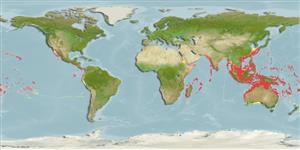>
Acanthuriformes (Surgeonfishes) >
Zanclidae (Moorish idol)
Etymology: Zanclus: Greek, za = an augmentative particle + Greek, agklino = to be on one´s back (Ref. 45335).
More on author: Linnaeus.
Environment: milieu / climate zone / depth range / distribution range
Ecologia
marinhas associadas(os) a recifes; intervalo de profundidade 0 - 182 m (Ref. 9710), usually 5 - 182 m (Ref. 27115). Subtropical; 24°C - 28°C (Ref. 27115); 32°N - 37°S, 21°E - 70°W
Indo-Pacific: East Africa to Rapa and Ducie islands, north to southern Japan and the Hawaiian Islands, south to the Lord Howe Island. Eastern Pacific: southern Gulf of California to Peru (Ref. 9267).
Tamanho / Peso / Idade
Maturity: Lm ? range ? - ? cm
Max length : 23.0 cm TL macho/indeterminado; (Ref. 6113); common length : 21.0 cm NG macho/indeterminado; (Ref. 5755)
Espinhos dorsais (total): 6 - 7; Raios dorsais (total): 39-43; Espinhos anais 3; Raios anais : 31 - 37. Strongly compressed discoid body. Tubular snout with a small mouth containing numerous elongate bristle-like teeth. Dorsal spines elongated into a whip-like filament.
Inhabit turbid inner lagoons, reef flats, and clear seaward rocky and coral reefs (Ref. 1602, 48637). Benthopelagic (Ref. 58302). Generally encountered in small groups of 2 or 3 individuals (Ref. 9267). Adults occur singly, in pairs and occasionally are seen in large schools (Ref. 48637). Feed on small encrusting animals (Ref. 6113). Size of metamorphosis from postlarva to juvenile is 7.5 cm (Ref. 9267). The long pelagic larval stage is the reason for the wide distribution and strong colouration that shows no geographical variation (Ref. 48637). Popular aquarium fish but rarely survives in tanks (Ref. 1602). Minimum depth reported taken from Ref. 128797.
Ciclo de vida ou comportamento de acasalamento
Maturidade | Reprodução | Desova | Ovos | Fecundidade | Larvas
Myers, R.F., 1991. Micronesian reef fishes. Second Ed. Coral Graphics, Barrigada, Guam. 298 p. (Ref. 1602)
Status na Lista Vermelha da UICN (Ref. 130435)
Ameaça para os humanos
Harmless
Uso pelos humanos
Pescarias: pesca de subsistência; Aquário: Espécies comerciais
Mais informação
Nomes comunsSinônimosMetabolismoPredadoresEcotoxicologiaReproduçãoMaturidadeDesovaAgregação de desovaFecundidadeOvosDesenvolvimento dos ovos
ReferênciasAquaculturaPerfil para aquaculturaEstirpesGenéticaElectrophoresesHereditariedadeDoençasProcessamentoNutrientsConversão de massa
Ferramentas
Relatórios especiais
Baixar XML
Fontes da internet
Estimates based on models
Preferred temperature (Ref.
123201): 20 - 29, mean 27.7 °C (based on 4016 cells).
Índice de diversidade filogenética (Ref.
82804): PD
50 = 1.5000 [Uniqueness, from 0.5 = low to 2.0 = high].
Bayesian length-weight: a=0.01738 (0.00674 - 0.04483), b=3.06 (2.84 - 3.28), in cm total length, based on LWR estimates for this (Sub)family-body shape (Ref.
93245).
Nível Trófico (Ref.
69278): 2.5 ±0.00 se; based on food items.
Fishing Vulnerability (Ref.
59153): Low vulnerability (13 of 100).
Nutrients (Ref.
124155): Calcium = 44.8 [19.5, 73.0] mg/100g; Iron = 0.697 [0.404, 1.262] mg/100g; Protein = 18.8 [17.5, 20.0] %; Omega3 = 0.175 [0.095, 0.315] g/100g; Selenium = 22.8 [10.2, 47.4] μg/100g; VitaminA = 29.5 [6.8, 126.5] μg/100g; Zinc = 1.05 [0.66, 1.62] mg/100g (wet weight);
